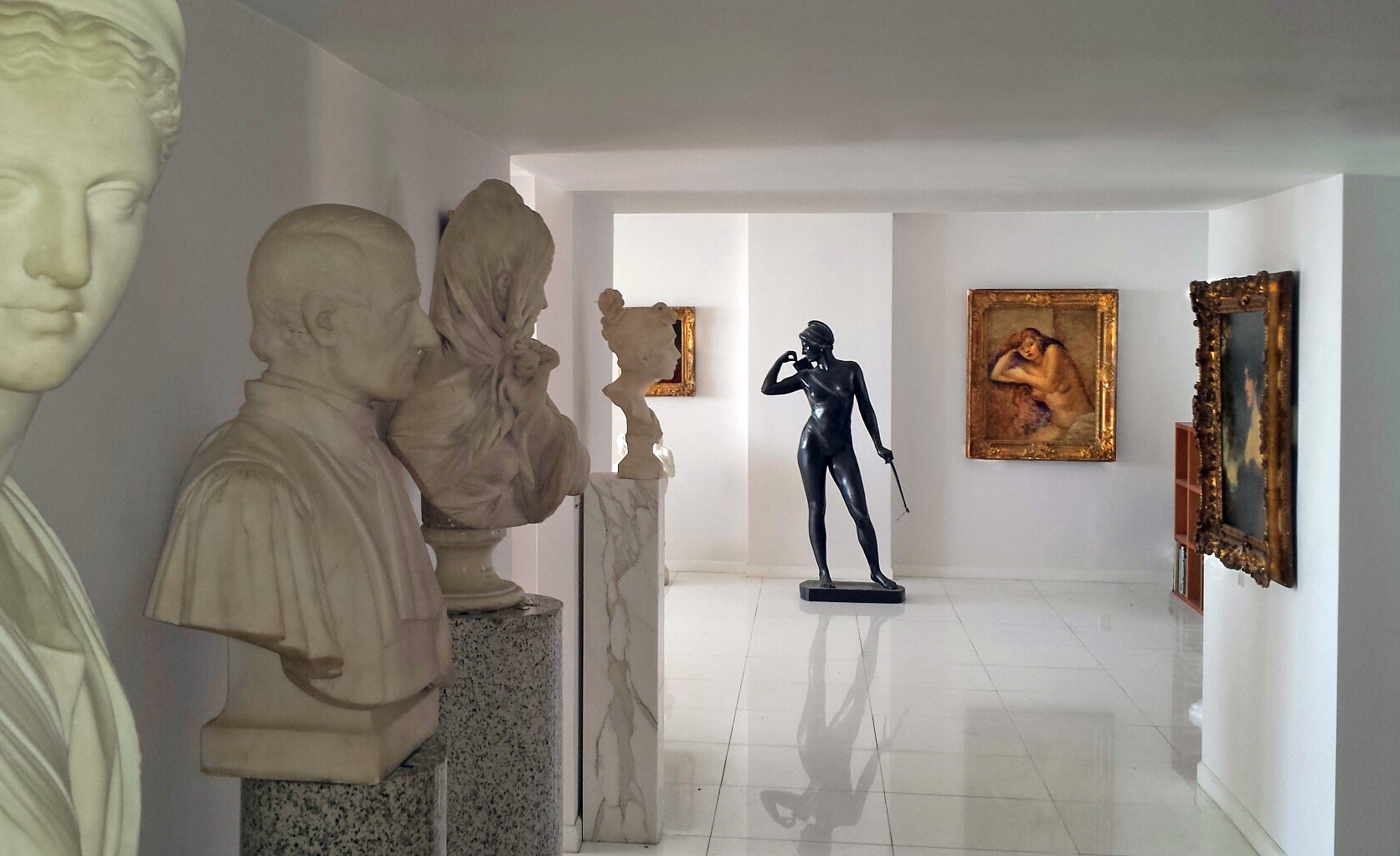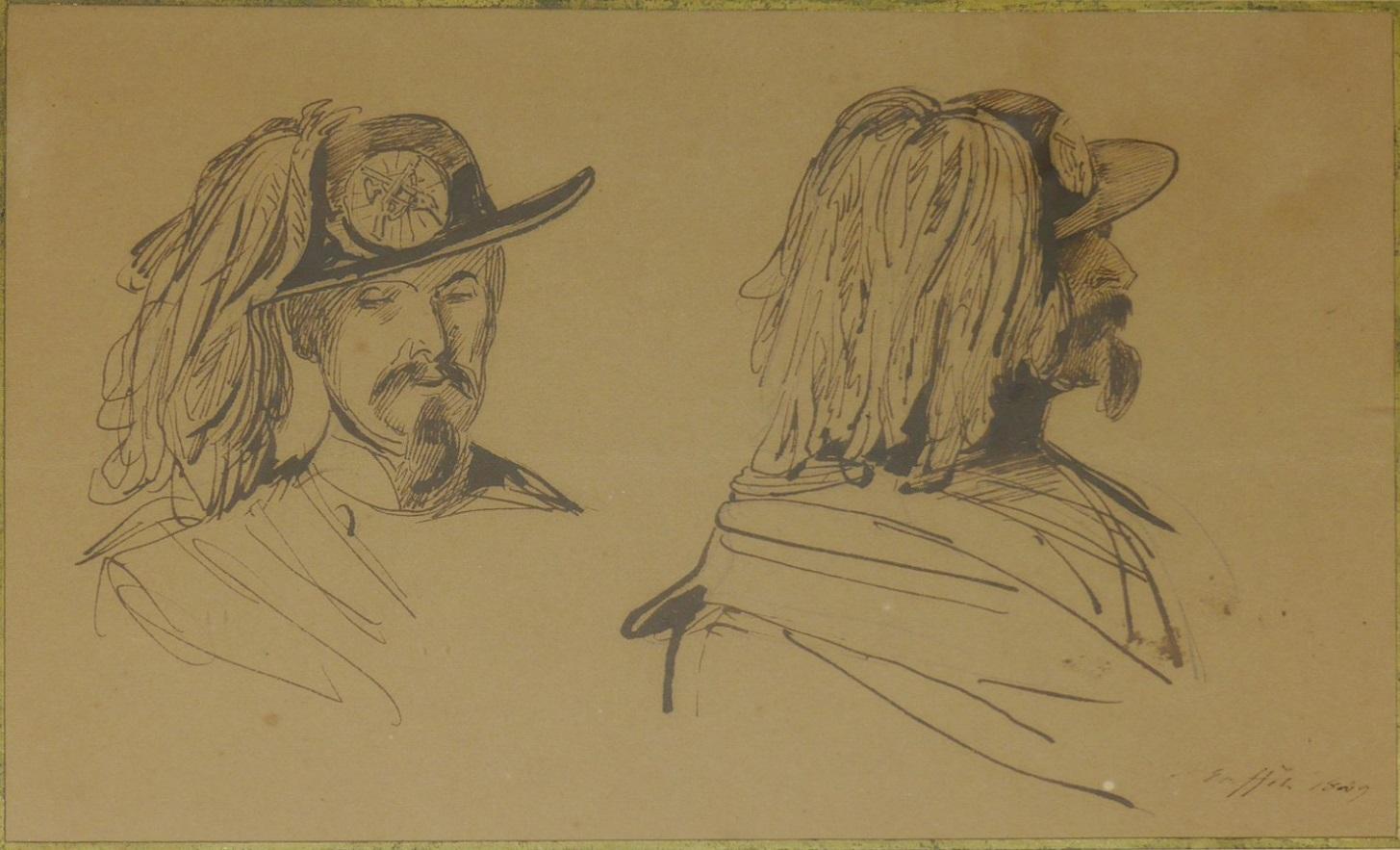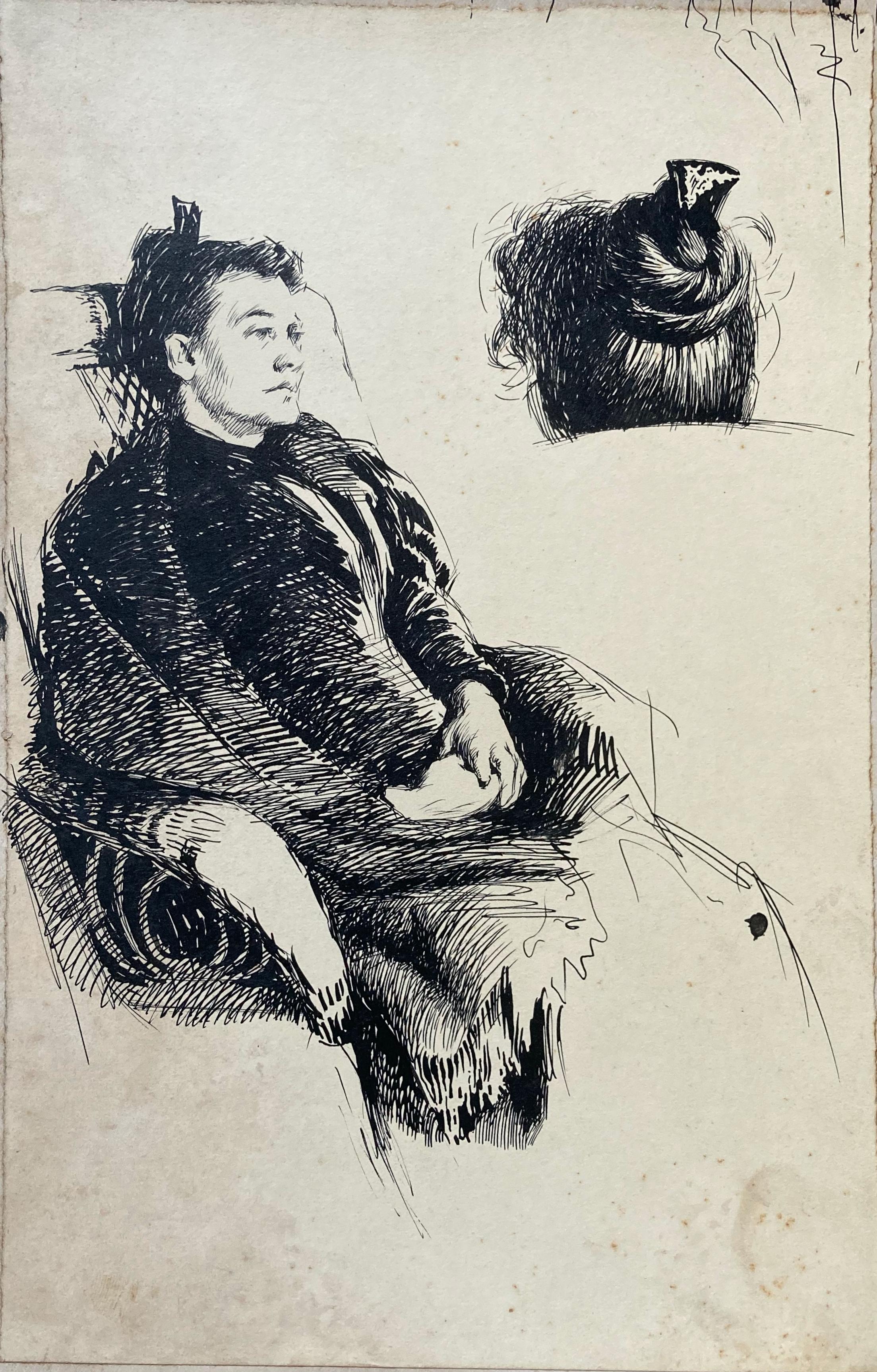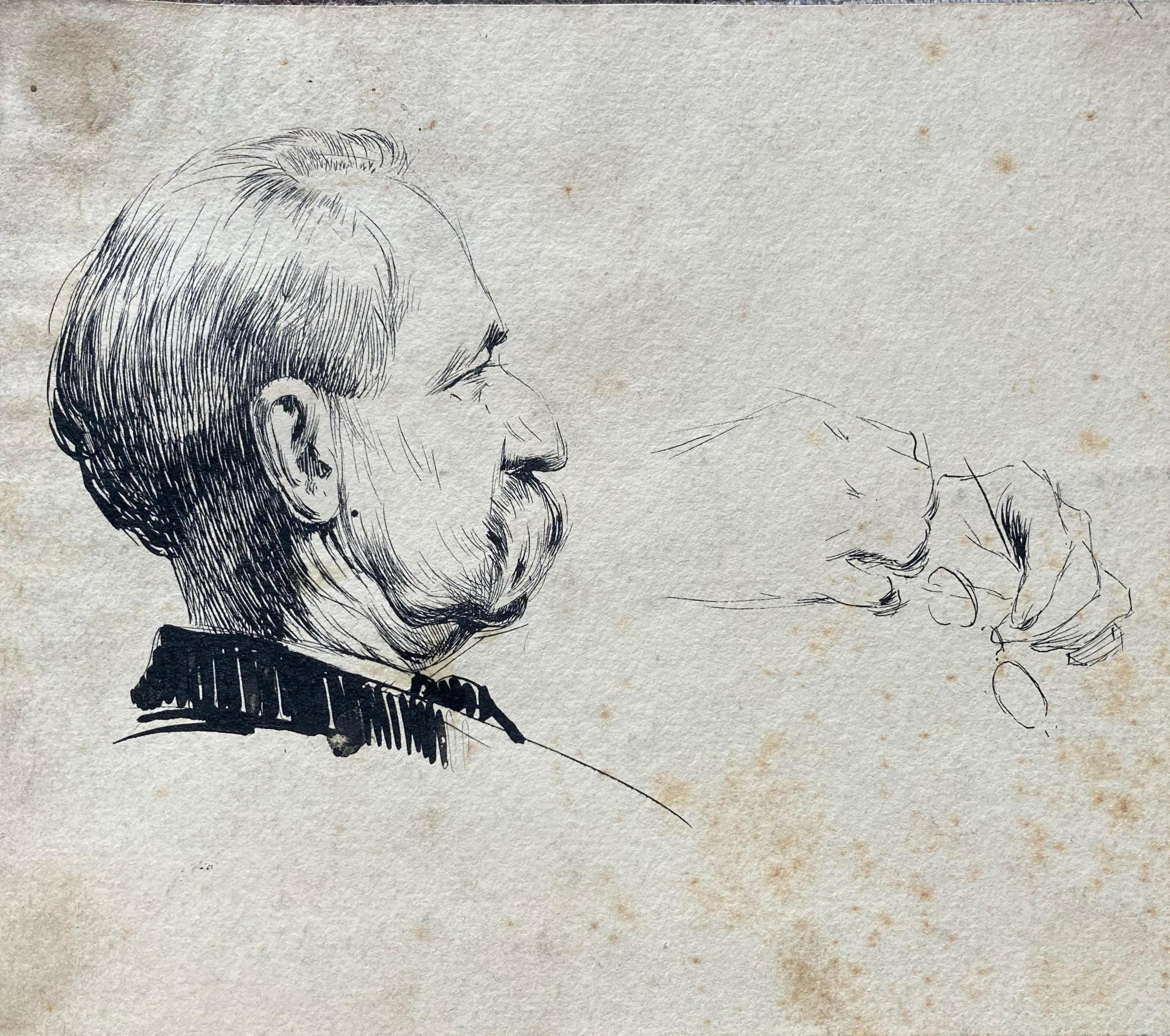Items Similar to Hand-Me-Downs - Street Children - Waif - Cockney Gutter Imps.
Want more images or videos?
Request additional images or videos from the seller
1 of 10
Edith FarmiloeHand-Me-Downs - Street Children - Waif - Cockney Gutter Imps. 1895 circa
1895 circa
About the Item
19th Century Street Art - British children's book author and illustrator Edith Farmiloe depicts a waif-like girl - Cockney Gutter Imp - who is disheveled. The artist draws her in a stylized manner to bring out all of the charm and personality of the subject. Signed upper right. Elegantly matted but not framed. Provenance: Chris Beetles Gallery.
"Her sketches, from her observing children playing on the streets, were used in Events of the Season, which appeared first in Little Folks magazine in November 1895".
Here work is in the collection of the Royal Academy
From Wikipedia,
Edith Farmiloe (1870–1921) was a British children's book author and illustrator, active from 1895 to about 1905.
Life
Edith Caroline Parnell was born in Gillingham, Kent, England, in 1870. Her father was Colonel Hon. Arthur Parnell (1841–1914) and her mother was Mary Anne Dunn.
On 7 April 1891, Edith married Venerable William Farmiloe, then vicar of St Peter's in Great Windmill Street, Soho, London. She was living with her husband at 124 Ashley Gardens, opposite Westminster Cathedral in 1901 and was by then listed in the census as an "artist'". In 1905, Rev. Farmiloe and his wife moved to South Hackney where he became vicar of St. Augustine's overlooking Victoria Park.
The Standard described All the World Over (1898) as "a pretty volume, brightly illustrated, representing funny children in the costumes of many countries."The Pall Mall Gazette called Rag, Tag, and Bobtail (1989) "one of the few books which deserve a place on the shelves of every (nursery) library." In its review of Piccalilli (1900), the same newspaper wrote that Farmiloe "has an exact eye for the humour and pathos of the children of the street, and her drawings are amazingly true to life, fresh, piquant, and convincing." A review in The Graphic described Chapel Street Children (1900) as "a book which will delight children of any age," adding that Farmiloe is "second to none in her delineations of Cockney gutter imps."
All the World Over London (East) – The Diamond Jubilee
Selected works
All the World Over (1898) with verses by writer E. V. Lucas[4]
The Bad family : & other stories (1898) with E. Fenwick
'Chousers' and other stories (1898) with Society for Promotion of Christian Knowledge (SPCK)
Rag, Tag and Bobtail (1898) with her sister, writer Winifred Parnell
Piccalilli (1900)
Chapel Street Children (1900)
The bountiful lady - or, how Mary was changed from a very miserable little girl to a very happy one (1900) with writer Thomas Cobb and other illustrators
Little Citizens (1901) with Society for Promotion of Christian Knowledge (SPCK)
Young George - his Life (1902)
Mr and Mrs Tiddliwinks (1902), with Society for Promotion of Christian Knowledge (SPCK)
One Day (1903) with other writers
Mr Biddle and the Dragon (1904)
Elizabeth over-the-Way (1905)
Our Darlings (1910) with writers W. Davenport Adams, Catharine Shaw, and other illustrators, Harry B. Neilson, Louis Wain.
- Creator:Edith Farmiloe (1870 - 1821, British)
- Creation Year:1895 circa
- Dimensions:Height: 5.2 in (13.21 cm)Width: 2.75 in (6.99 cm)
- Medium:
- Movement & Style:
- Period:
- Condition:overall good condition - light toning around the perimeter - light smudge center right otherwise presents well.
- Gallery Location:Miami, FL
- Reference Number:1stDibs: LU385314038722

About the Seller
4.9
Platinum Seller
These expertly vetted sellers are 1stDibs' most experienced sellers and are rated highest by our customers.
Established in 2005
1stDibs seller since 2016
102 sales on 1stDibs
Typical response time: 1 hour
- ShippingRetrieving quote...Ships From: Miami, FL
- Return PolicyA return for this item may be initiated within 3 days of delivery.
More From This SellerView All
- Romantic Couple In Wartime Paris on Rainy Parisian NightLocated in Miami, FLThe technique and subject matter work well together in this loosely but masterfully rendered World War 1 romantic illustration of a Soldier and a Parisian woman. Even though this wo...Category
1930s Romantic Figurative Drawings and Watercolors
MaterialsInk, Watercolor, Pencil
- The Little Mermaid - Fairy Tales - English Female Illustrator Pen and InkLocated in Miami, FLPioneering English Female Illustrator Helen Stratton masterfully renders in pen and ink a scene from "The Little Mermaid" in George Newnes's 1899 editi...Category
1890s Pre-Raphaelite Figurative Drawings and Watercolors
MaterialsInk, Paper, Pen
- Native American Indian Portrait in Pen and InkBy Murray TinkelmanLocated in Miami, FLStunning use of cross-hatching. Close up this is an abstract drawing. Ink on Strathmore Bristol Board - Perfect Condition and looks better in person. Elegantly matted but not framedCategory
1970s American Realist Portrait Drawings and Watercolors
MaterialsInk, Pen
- Wonderland Tale - Fairy Tale - Female IllustratorLocated in Miami, FLWonderland Tale - Fairy Tale - Female Illustrator - The work is meticulously rendered in an exacting technique of line to the point of wonderment. Yet, Baxter can obtain an ethereali...Category
1950s English School Figurative Drawings and Watercolors
MaterialsInk, Pen
- Mother and Child, Golden Age of IllustrationBy Jessie Willcox SmithLocated in Miami, FLAmerica's greatest female illustrator draws a heartwarming picture of a mother putting to bed her child. Motherly love towards their children is the artist's most iconic theme. This ...Category
Early 1900s Art Nouveau Figurative Drawings and Watercolors
MaterialsInk, Illustration Board, Pen
- Abstract Silhouette Hat Portraits - Female Illustrator of Golden AgeBy Jessie GillespieLocated in Miami, FL115 years after they were created, one can view these silhouettes differently than the artist’s intent. After all, the genesis of this work was an editorial illustration for Life Magazine to showcase elaborate women’s hats. They were done for a commercial assignment with a deadline, and picky editors were overseeing the final work. Today, they have a dual meaning. These charming silhouettes are abstractions as much as they are representations. Moreover, each one is a compact little gem stuffed with observational detail. Golden Age female illustrator Jesse Gillespie's mastery of technical skill, is apparent in minute details and composition. Young women, old women, pendants, necklaces, feathers, and laced vails all contribute to the works understated complexity. The identity of the subjects are revealed by small areas of exposed neck and chin. As the viewers eyes goes from left to right - all six silhouettes read as fashion hieroglyphs in a sentence with a visual rhythm and cadence. . Initialed JG lower right., Matted but not framed. Published: Life Magazine, March 17th, 1910. Provenance: Honey and Wax Bookstore ________________________________ From Wikipedia, the free encyclopedia Jessie Gillespie Willing (March 28, 1888 – August 1, 1972) was an American illustrator during the Golden Age of illustration. She was considered the foremost silhouette illustrator of her time, although she did traditional illustration as well. Willing illustrated for books and magazines including Life, The Ladies' Home Journal, Woman's Home Companion, Mother and Child, McClure's Magazine, Childhood Education, the Sunday Magazine, Association Men (the magazine of the YMCA), Farm and Fireside, Every Week, Children: The Magazine for Parents (which became Parents Magazine), and the American Magazine. She is perhaps most well known for her work for the Girl Scouts. Early life Willing was born in Brooklyn on March 28, 1888 to John Thomson Willing (August 4, 1860 – July 8, 1947)[1][2] and Charlotte Elizabeth Van Der Veer Willing (December 1, 1859 – March 4, 1930).[3] Thomson Willing was a noted illustrator and art editor. He was also well known for finding new artistic talent. Jessie Willing was the eldest of three children. Her brother Van Der Veer (November 30, 1889 – January 14, 1919), who died of pneumonia at the age of 29, was an advertising agent.[4] Her sister Elizabeth Hunnewell Willing (July 26, 1908 – August 15, 1991) was one of the first women to graduate from the Philadelphia Divinity School.[5][6] Elizabeth married the Rev. Orrin Judd, rector of St. Mary's Episcopal Church, on September 22, 1931, and was active in church work.[citation needed] The Willing family moved to the Germantown neighborhood of Philadelphia in 1901 or 1902. Jessie Willing attended the Stevens School, from which she graduated in 1905. She then went on to attend the Philadelphia Academy of Fine Arts from 1906 to 1907.[7][8] Career Willing used her middle name Gillespie as her professional surname. She also often signed her illustrations J.G.[9] The story goes that the art editor of Life magazine was in Thomson Willing's office when he was the art editor of the Associated Sunday Magazine syndicate. Thomson Willing had some of Jessie's artwork on his desk, which the Life editor saw and admired. He asked for the artist's information so that he could give her freelance work. Thomson Willing did not want to be accused of nepotism so he persuaded Jessie to use Jessie Gillespie as her professional name, which she did.[10][11] In addition to her extensive illustration work, Willing was also the editor of Heirlooms and Masterpieces from 1922 to 1931 and the art editor of Jewelers' Circular-Keystone from 1933 to 1939.[12] She specialized in jewelry publicity and advertising. In 1966 she won the Gold medal of the Printing Week Graphic Arts Exhibit in Philadelphia for her Christmas catalog for J.E. Caldwell Co., Philadelphia. Willing was a member of the Plastic Club of Philadelphia,[13] the American Institute of Graphic Arts (AIGA) and the National Arts Club of New York.[14] She was an honorary life member of the National Arts Club[15] and served on its Board of Governors from 1941-1970. In 1963, she received the Gold Medal of the National Arts Club in recognition of 32 years of selfless devotion.[15] Additionally, she was the national director of the American Institute of Graphic Arts (AIGA) from 1943 to 1946.[15] Previous to this she served as the Program Chairman of the AIGA and in that position she put together a travelling exhibit on the "history of narrative art from the first recorded picture story to the comic book of the twentieth century."[16][17] Illustrations in books With Tongue and Pen--Frederick Bair, et al. (MacMillan, 1940) Masoud the Bedouin--Alfred Post Carhart (Missionary Education Movement, 1915) The Path of the Gopatis--Zilpha Carruthers (National Dairy Council, 1926) The Schoolmaster and His Son: A Narrative of the Thirty Years War--Karl Heinrich Caspari (Lutheran Publication Society, 1917) On a Rainy Day--Dorothy Canfield Fisher and Sarah Scott Fisher (A.S. Barnes and Co., 1938) Book of Games for Home, School and Playground--William B. Forbush and Harry R Allen...Category
1910s Victorian Portrait Drawings and Watercolors
MaterialsInk, Illustration Board, Pen
You May Also Like
- Denis Auguste Raffet (1804-1860) Studies of a Tiroler Kaiserjäger, drawingBy Denis Auguste Marie RaffetLocated in Paris, FRDenis Auguste Raffet (1804-1860) Studies of a Tiroler Kaiserjäger, Signed and dated 1849 lower right Ink on paper 16.5 x 25.5 cm In a nice period frame : 33 x 42 cm Raffet had the occasion to draw studies of austrian soldiers as he took part as observer to the first Italian Independance War (1848-1849). It was the the first of many conflicts between the Kingdom of Sardinia , which later became the Kingdom of Italy , and the Austrian Empire. The Kaiserjäger (imperial hunters) were founded in 1815 by Emperor Franz I. It was a great honor to enter the Kaiserjäger as they were the only ones to be honored with the term "imperial". However, only Tyrolese, Voralbergers and Welschtirolers were allowed. They wore this characteristic hat as a parade headdress, it was made of matte black, waterproof felt. It consisted of a crown and brim adorned with a circular, green cord, the Jäger emblem and a plume of black rooster feathers. The hat cord was made of sheep's wool, and had a button and an acorn covered with a green wool. These two studies clearly evoke the interest of the artist for this part of their uniform. Denis Auguste Marie Raffet (2 March 1804 – 16 February 1860) was a French illustrator and lithographer. He was a student of Nicolas Toussaint Charlet, and was a retrospective painter of the Empire. At an early age he was apprenticed to a wood turner, but took up the study of art at evening classes. At the age of 18 he entered the workshop of Cabanel, where he applied his skill to the decoration of china, and where he met Rudor, from whom he received instruction in lithography, in the practice of which he was to rise to fame. He then entered the École des Beaux-Arts, but returned to lithography in 1830 when he produced on stone his famous designs of Lützen, Waterloo, Le bal, La revue, and Les adieux de la garrison, by which his reputation became immediately established. Raffet's chief works were his lithographs of the Napoleonic campaigns, from Egypt to Waterloo, vigorous designs inspired by ardent patriotic enthusiasm. In this endeavor he was a contemporary of other French artist-lithographers of Napoleon and the French army including Hippolyte Bellangé, Horace Vernet, and Nicolas Toussaint Charlet. As an illustrator his activity was prodigious, the list of works illustrated by his crayon amounting to about forty-five, among which are Béranger's poems, the History of the Revolution by Adolphe Thiers, the History of Napoleon by de Norvins, the great Walter Scott by Auguste Defauconpret, the French Plutarch and Frédéric Bérat's Songs. He went to Rome in 1849, and was present at the siege of Rome, which he made the subject of some lithographs, and followed the Italian campaign of 1859, of which he left a record in his Episodes de la campagne d'Italie de 1859. His portraits in pencil...Category
1840s Romantic Portrait Drawings and Watercolors
MaterialsInk
- Seated Young Lady (by leader of "Southern Art Renaissance") - Antique DrawingBy Ellsworth WoodwardLocated in New Orleans, LAMany of you clicking on this pen-and-ink of a pretty Edwardian-era lady are probably doing so because you know of Ellsworth Woodward, who with his brother William Woodward around the...Category
1890s Romantic Portrait Drawings and Watercolors
MaterialsInk
- Study for a Seated Woman (by leader of "Southern Art Renaissance")By Ellsworth WoodwardLocated in New Orleans, LAMany of you clicking on this wonderful pen-and-ink are probably doing so because you know of Ellsworth Woodward, who with his brother William Woodward around the turn of the 20th century sparked an arts renaissance in the South, the arts and culture in general having been mostly moribund since the dispiriting defeat experienced in the Civil War. I won't bog you down with lots of detail here since all you have to do is Google his name to bring up a wealth of information about him. He is most famous for his leadership of the arts program at Newcomb College in New Orleans, and its famous Newcomb Pottery...Category
1890s Romantic Portrait Drawings and Watercolors
MaterialsInk
- Denis Auguste Raffet (1804-1860) Studies of characters, drawing and watercolorBy Denis Auguste Marie RaffetLocated in Paris, FRDenis Auguste Raffet (1804-1860) Studies of characters Black pencil and watercolor on paper 18.5 x 25.5 cm Stamp of the Raffet Estate Sale (1911) on the lower right In good condition, foxings on the original mount Framed 34 x 40 cm Denis Auguste Marie Raffet (2 March 1804 – 16 February 1860) was a French illustrator and lithographer. He was a student of Nicolas Toussaint Charlet, and was a retrospective painter of the Empire. At an early age he was apprenticed to a wood turner, but took up the study of art at evening classes. At the age of 18 he entered the workshop of Cabanel, where he applied his skill to the decoration of china, and where he met Rudor, from whom he received instruction in lithography, in the practice of which he was to rise to fame. He then entered the École des Beaux-Arts, but returned to lithography in 1830 when he produced on stone his famous designs of Lützen, Waterloo, Le bal, La revue, and Les adieux de la garrison, by which his reputation became immediately established.[ Raffet's chief works were his lithographs of the Napoleonic campaigns, from Egypt to Waterloo, vigorous designs inspired by ardent patriotic enthusiasm. In this endeavor he was a contemporary of other French artist-lithographers of Napoleon and the French army including Hippolyte Bellangé, Horace Vernet, and Nicolas Toussaint Charlet. As an illustrator his activity was prodigious, the list of works illustrated by his crayon amounting to about forty-five, among which are Béranger's poems, the History of the Revolution by Adolphe Thiers, the History of Napoleon by de Norvins, the great Walter Scott by Auguste Defauconpret, the French Plutarch and Frédéric Bérat's Songs. He went to Rome in 1849, and was present at the siege of Rome, which he made the subject of some lithographs, and followed the Italian campaign of 1859, of which he left a record in his Episodes de la campagne d'Italie de 1859. His portraits in pencil...Category
1850s Romantic Portrait Drawings and Watercolors
MaterialsInk, Watercolor
- Gentleman with Mustache (by leader of "Southern Art Renaissance") - AntiqueBy Ellsworth WoodwardLocated in New Orleans, LAMany of you clicking on this are probably doing so because you know of Ellsworth Woodward, who with his brother William Woodward around the turn of the 20th century sparked an arts renaissance in the South, the arts and culture in general having been mostly moribund since the dispiriting defeat experienced in the Civil War. I won't bog you down with lots of detail here since all you have to do is Google his name to bring up a wealth of information about him. He is most famous for his leadership of the arts program at Newcomb College in New Orleans, and its famous Newcomb Pottery...Category
1890s Romantic Portrait Drawings and Watercolors
MaterialsInk
- Follower of Francis Wheatley, 19th century portrait of young maiden with flowersBy Francis WheatleyLocated in Harkstead, GBA really charming, early 19th century portrait of a young maiden carrying a basket of flowers. The face is beautifully painted with a slight blush to her cheeks and striking touches ...Category
Early 19th Century Romantic Figurative Drawings and Watercolors
MaterialsWatercolor, Paper, Pencil
Recently Viewed
View AllMore Ways To Browse
Woodblock Butterfly
Vertes Watercolor
Miniature Rocking Horse
Vera Walther
Henri Wormser
1870s Salon Set
Spencer Tracy
Robot Dress
Missouri Impressionism
Remy De Gourmont
Still Life Wine And Cheese
16th Century Embroidery Russian
Hermes Birkin Building Bag
Simcha Even Chen
Tea Pot 70s
Vena Gallery
Antique Kentucky Prints
Edwin Booth





